
Mammoth Peak over Tuolumne Meadows, Tioga Pass, Yosemite National Park.
Location: Yosemite National Park, California
Image ID: 28514
Location: Yosemite National Park, California
Image ID: 28514

Panorama of the Minarets at sunrise, near Mammoth Mountain. The Minarets are a series of seventeen jagged peaks in the Ritter Range, west of Mammoth Mountain in the Ansel Adams Wilderness. These basalt peaks were carved by glaciers on both sides of the range. The highest of the Minarets stands 12,281 feet above sea level.
Location: Mammoth Lakes, California
Image ID: 19126
Panorama dimensions: 3249 x 29914
Location: Mammoth Lakes, California
Image ID: 19126
Panorama dimensions: 3249 x 29914
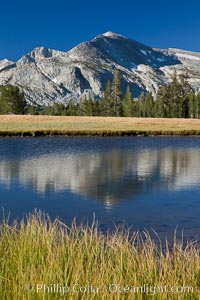
Mammoth Peak (12,117') reflected in small tarn pond at sunrise, viewed from meadows near Tioga Pass.
Location: Yosemite National Park, California
Image ID: 25758
Location: Yosemite National Park, California
Image ID: 25758

Mammoth Peak (12,117') reflected in small tarn pond at sunrise, viewed from meadows near Tioga Pass.
Location: Yosemite National Park, California
Image ID: 25759
Location: Yosemite National Park, California
Image ID: 25759

Mammoth Peak and alpine meadows in the High Sierra are reflected in Tioga Lake at sunrise. This spectacular location is just a short walk from the Tioga Pass road. Near Tuolumne Meadows and Yosemite National Park.
Location: Tioga Lake, Yosemite National Park, California
Image ID: 09949
Location: Tioga Lake, Yosemite National Park, California
Image ID: 09949

Mammoth Peak in the High Sierra range is reflected in Tioga Lake at sunrise. This spectacular location is just a short walk from the Tioga Pass road. Near Tuolumne Meadows and Yosemite National Park.
Location: Tioga Lake, Yosemite National Park, California
Image ID: 09948
Location: Tioga Lake, Yosemite National Park, California
Image ID: 09948

Mammoth Peak over Tuolumne Meadows, Tioga Pass, Yosemite National Park.
Location: Yosemite National Park, California
Image ID: 28510
Location: Yosemite National Park, California
Image ID: 28510

Devil's Postpile, a spectacular example of columnar basalt. Once molten and under great pressure underground, the lava that makes up Devil's Postpile cooled evenly and slowly, contracting and fracturing into polygonal-sided columns. The age of the formation is estimated between 100 and 700 thousand years old. Sometime after the basalt columns formed, a glacier passed over the formation, cutting and polishing the tops of the columns. The columns have from three to seven sides, varying because of differences in how quickly portions of the lava cooled.
Location: Devils Postpile National Monument, California
Image ID: 23266
Location: Devils Postpile National Monument, California
Image ID: 23266
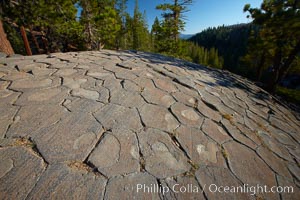
Devil's Postpile, a spectacular example of columnar basalt. Once molten and under great pressure underground, the lava that makes up Devil's Postpile cooled evenly and slowly, contracting and fracturing into polygonal-sided columns. The age of the formation is estimated between 100 and 700 thousand years old. Sometime after the basalt columns formed, a glacier passed over the formation, cutting and polishing the tops of the columns. The columns have from three to seven sides, varying because of differences in how quickly portions of the lava cooled.
Location: Devils Postpile National Monument, California
Image ID: 23267
Location: Devils Postpile National Monument, California
Image ID: 23267

Devil's Postpile, a spectacular example of columnar basalt. Once molten and under great pressure underground, the lava that makes up Devil's Postpile cooled evenly and slowly, contracting and fracturing into polygonal-sided columns. The age of the formation is estimated between 100 and 700 thousand years old. Sometime after the basalt columns formed, a glacier passed over the formation, cutting and polishing the tops of the columns. The columns have from three to seven sides, varying because of differences in how quickly portions of the lava cooled.
Location: Devils Postpile National Monument, California
Image ID: 23285
Location: Devils Postpile National Monument, California
Image ID: 23285

Mammoth Peak rises above a placid Tioga Lake, at sunrise.
Location: Tioga Lake, Yosemite National Park, California
Image ID: 23291
Location: Tioga Lake, Yosemite National Park, California
Image ID: 23291

Mammoth Peak (12,117') rises above grassy meadows and granite boulders near Tioga Pass.
Location: Yosemite National Park, California
Image ID: 25766
Location: Yosemite National Park, California
Image ID: 25766

Mammoth Peak over Tuolumne Meadows, Tioga Pass, Yosemite National Park.
Location: Yosemite National Park, California
Image ID: 28511
Location: Yosemite National Park, California
Image ID: 28511

Panoramic Photo of Crystal Lake, Mammoth Lakes, Inyo National Forest.
Location: Mammoth Lakes, Inyo National Forest, California
Image ID: 31188
Panorama dimensions: 5659 x 19050
Location: Mammoth Lakes, Inyo National Forest, California
Image ID: 31188
Panorama dimensions: 5659 x 19050
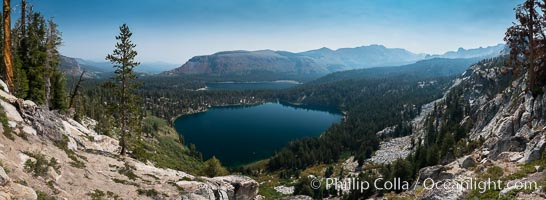
Panoramic Photo of Lake George, Mammoth Lakes, Inyo National Forest.
Location: Mammoth Lakes, Inyo National Forest, California
Image ID: 31189
Panorama dimensions: 5772 x 15775
Location: Mammoth Lakes, Inyo National Forest, California
Image ID: 31189
Panorama dimensions: 5772 x 15775

Devil's Postpile, a spectacular example of columnar basalt. Once molten and under great pressure underground, the lava that makes up Devil's Postpile cooled evenly and slowly, contracting and fracturing into polygonal-sided columns. The age of the formation is estimated between 100 and 700 thousand years old. Sometime after the basalt columns formed, a glacier passed over the formation, cutting and polishing the tops of the columns. The columns have from three to seven sides, varying because of differences in how quickly portions of the lava cooled.
Location: Devils Postpile National Monument, California
Image ID: 23281
Location: Devils Postpile National Monument, California
Image ID: 23281

Devil's Postpile, a spectacular example of columnar basalt. Once molten and under great pressure underground, the lava that makes up Devil's Postpile cooled evenly and slowly, contracting and fracturing into polygonal-sided columns. The age of the formation is estimated between 100 and 700 thousand years old. Sometime after the basalt columns formed, a glacier passed over the formation, cutting and polishing the tops of the columns. The columns have from three to seven sides, varying because of differences in how quickly portions of the lava cooled.
Location: Devils Postpile National Monument, California
Image ID: 23282
Location: Devils Postpile National Monument, California
Image ID: 23282

Devil's Postpile, a spectacular example of columnar basalt. Once molten and under great pressure underground, the lava that makes up Devil's Postpile cooled evenly and slowly, contracting and fracturing into polygonal-sided columns. The age of the formation is estimated between 100 and 700 thousand years old. Sometime after the basalt columns formed, a glacier passed over the formation, cutting and polishing the tops of the columns. The columns have from three to seven sides, varying because of differences in how quickly portions of the lava cooled.
Location: Devils Postpile National Monument, California
Image ID: 23283
Location: Devils Postpile National Monument, California
Image ID: 23283

Devil's Postpile, a spectacular example of columnar basalt. Once molten and under great pressure underground, the lava that makes up Devil's Postpile cooled evenly and slowly, contracting and fracturing into polygonal-sided columns. The age of the formation is estimated between 100 and 700 thousand years old. Sometime after the basalt columns formed, a glacier passed over the formation, cutting and polishing the tops of the columns. The columns have from three to seven sides, varying because of differences in how quickly portions of the lava cooled.
Location: Devils Postpile National Monument, California
Image ID: 23284
Location: Devils Postpile National Monument, California
Image ID: 23284
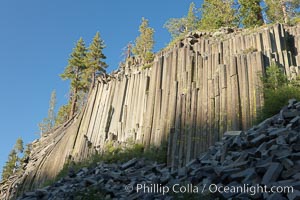
Devil's Postpile, a spectacular example of columnar basalt. Once molten and under great pressure underground, the lava that makes up Devil's Postpile cooled evenly and slowly, contracting and fracturing into polygonal-sided columns. The age of the formation is estimated between 100 and 700 thousand years old. Sometime after the basalt columns formed, a glacier passed over the formation, cutting and polishing the tops of the columns. The columns have from three to seven sides, varying because of differences in how quickly portions of the lava cooled.
Location: Devils Postpile National Monument, California
Image ID: 23286
Location: Devils Postpile National Monument, California
Image ID: 23286
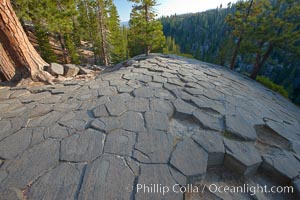
Devil's Postpile, a spectacular example of columnar basalt. Once molten and under great pressure underground, the lava that makes up Devil's Postpile cooled evenly and slowly, contracting and fracturing into polygonal-sided columns. The age of the formation is estimated between 100 and 700 thousand years old. Sometime after the basalt columns formed, a glacier passed over the formation, cutting and polishing the tops of the columns. The columns have from three to seven sides, varying because of differences in how quickly portions of the lava cooled.
Location: Devils Postpile National Monument, California
Image ID: 23287
Location: Devils Postpile National Monument, California
Image ID: 23287
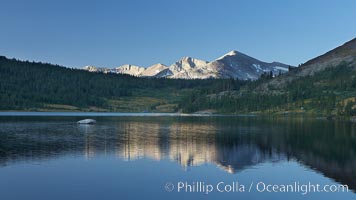
Mammoth Peak rises above a placid Tioga Lake, at sunrise.
Location: Tioga Lake, Yosemite National Park, California
Image ID: 23268
Location: Tioga Lake, Yosemite National Park, California
Image ID: 23268

Mammoth Peak rises above a placid Tioga Lake, at sunrise.
Location: Tioga Lake, Yosemite National Park, California
Image ID: 23290
Location: Tioga Lake, Yosemite National Park, California
Image ID: 23290

Mammoth Peak (12,117') reflected in small tarn pond at sunrise, viewed from meadows near Tioga Pass.
Location: Yosemite National Park, California
Image ID: 25773
Location: Yosemite National Park, California
Image ID: 25773

Mammoth Peak over Tuolumne Meadows, Tioga Pass, Yosemite National Park.
Location: Yosemite National Park, California
Image ID: 28512
Location: Yosemite National Park, California
Image ID: 28512

Mammoth Peak, reflected in a small alpine tarn (pond) at Tioga Pass, with meadow grasses and trees.
Location: Yosemite National Park, California
Image ID: 23269
Location: Yosemite National Park, California
Image ID: 23269

Mammoth Peak over Tuolumne Meadows, Tioga Pass, Yosemite National Park.
Location: Yosemite National Park, California
Image ID: 28513
Location: Yosemite National Park, California
Image ID: 28513

Mammoth Peak over Tuolumne Meadows, Tioga Pass, Yosemite National Park.
Location: Yosemite National Park, California
Image ID: 28515
Location: Yosemite National Park, California
Image ID: 28515

Mammoth Peak over Tuolumne Meadows, Tioga Pass, Yosemite National Park.
Location: Yosemite National Park, California
Image ID: 28516
Location: Yosemite National Park, California
Image ID: 28516

Mammoth Peak (12,117') reflected in small tarn pond at sunrise, viewed from meadows near Tioga Pass.
Location: Yosemite National Park, California
Image ID: 25792
Location: Yosemite National Park, California
Image ID: 25792